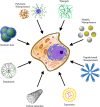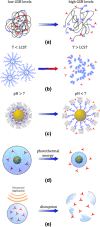Stimuli-responsive nanocarriers for intracellular delivery
- PMID: 29178081
- PMCID: PMC5711703
- DOI: 10.1007/s12551-017-0341-z
Stimuli-responsive nanocarriers for intracellular delivery
Abstract
The emergence of different nanoparticles (NPs) has made a significant revolution in the field of medicine. Different NPs in the form of metallic NPs, dendrimers, polymeric NPs, carbon quantum dots and liposomes have been functionalized and used as platforms for intracellular delivery of biomolecules, drugs, imaging agents and nucleic acids. These NPs are designed to improve the pharmacokinetic properties of the drug, improve their bioavailability and successfully surpass physiological or pathological obstacles in the biological system so that therapeutic efficacy is achieved. In this review I present some of the current approaches used in intracellular delivery systems, with a focus on various stimuli-responsive nanocarriers, including cell-penetrating peptides, to highlight their various biomedical applications.
Keywords: Drug delivery; Intelligent materials; Nanocarrier; Nanomedicine; Stimuli-responsive.
Conflict of interest statement
Lemmuel L. Tayo declares that he has no conflicts of interest.
Figures


Similar articles
-
Stimuli-Responsive Polymeric Nanocarriers for Drug Delivery, Imaging, and Theragnosis.Polymers (Basel). 2020 Jun 22;12(6):1397. doi: 10.3390/polym12061397. Polymers (Basel). 2020. PMID: 32580366 Free PMC article. Review.
-
Functional DNA Molecules Enable Selective and Stimuli-Responsive Nanoparticles for Biomedical Applications.Acc Chem Res. 2019 Sep 17;52(9):2415-2426. doi: 10.1021/acs.accounts.9b00167. Epub 2019 Aug 14. Acc Chem Res. 2019. PMID: 31411853 Free PMC article. Review.
-
Emerging Strategies in Stimuli-Responsive Nanocarriers as the Drug Delivery System for Enhanced Cancer Therapy.Curr Pharm Des. 2019;25(24):2609-2625. doi: 10.2174/1381612825666190709221141. Curr Pharm Des. 2019. PMID: 31603055 Review.
-
A review of stimuli-responsive nanocarriers for drug and gene delivery.J Control Release. 2008 Mar 20;126(3):187-204. doi: 10.1016/j.jconrel.2007.12.017. Epub 2008 Jan 11. J Control Release. 2008. PMID: 18261822 Review.
-
Internal stimuli-responsive nanocarriers for drug delivery: Design strategies and applications.Mater Sci Eng C Mater Biol Appl. 2017 Feb 1;71:1267-1280. doi: 10.1016/j.msec.2016.11.030. Epub 2016 Nov 10. Mater Sci Eng C Mater Biol Appl. 2017. PMID: 27987683 Review.
Cited by
-
Cell-Penetrating Peptides.Methods Mol Biol. 2022;2383:3-32. doi: 10.1007/978-1-0716-1752-6_1. Methods Mol Biol. 2022. PMID: 34766279
-
An energy-blocking nanoparticle decorated with anti-VEGF antibody to reverse chemotherapeutic drug resistance.RSC Adv. 2019 Apr 16;9(21):12110-12123. doi: 10.1039/c9ra01356c. eCollection 2019 Apr 12. RSC Adv. 2019. PMID: 35548379 Free PMC article.
-
Advances of Stimuli-Responsive Amphiphilic Copolymer Micelles in Tumor Therapy.Int J Nanomedicine. 2025 Jan 1;20:1-24. doi: 10.2147/IJN.S495387. eCollection 2025. Int J Nanomedicine. 2025. PMID: 39776491 Free PMC article. Review.
-
Mussel-inspired biomaterials: From chemistry to clinic.Bioeng Transl Med. 2022 Aug 11;7(3):e10385. doi: 10.1002/btm2.10385. eCollection 2022 Sep. Bioeng Transl Med. 2022. PMID: 36176595 Free PMC article. Review.
-
Endophytic Nanotechnology: An Approach to Study Scope and Potential Applications.Front Chem. 2021 May 25;9:613343. doi: 10.3389/fchem.2021.613343. eCollection 2021. Front Chem. 2021. PMID: 34113600 Free PMC article. Review.
References
-
- Allen TM. Ligand-targeted therapeutics in anticancer therapy. Nat Rev Cancer. 2002;2:750–763. - PubMed
-
- Babin J, Pelletier M, Lepage M, Allard J-F, Morris D, Zhao Y. A new two-photon sensitive block copolymer nanocarrier. Angew Chem Int Ed. 2009;48:3329–3332. - PubMed
-
- Baghbani F, Moztarzadeh F. Bypassing multidrug resistant ovarian cancer using ultrasoundresponsive doxorubicin/curcumin co-deliver alginate nanodroplets. Colloids Surf B Biointerfaces. 2017;153:132–140. - PubMed
-
- Baghbani F, Chegeni M, Moztarzadeh F, Hadian-Ghazvini S, Raz M. Novel ultrasound-responsive chitosan/perfluorohexane nanodroplets for image-guided smart delivery of an anticancer agent: curcumin. Mater Sci Eng C. 2017;74:186–193. - PubMed
-
- Baghbani F, Chegeni M, Moztarzadeh F, Mohandesi JA, Mokhtari-Dizaji M. Ultrasonic nanotherapy of breast cancer using novel ultrasound-responsive alginate-shelled perfluorohexane nanodroplets: in vitro and in vivo evaluation. Mater Sci Eng C. 2017;77:698–707. - PubMed
Publication types
LinkOut - more resources
Full Text Sources
Other Literature Sources

